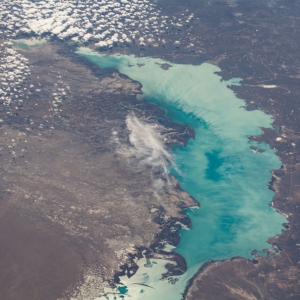The Stream, July 9, 2021: Colorado River Indian Tribes Play Crucial Role In Drought Management
YOUR GLOBAL RUNDOWN
- Dry conditions overwhelming much of the American West are shrinking the region’s largest natural lake, in Utah, while Native American tribes along the Colorado River are playing a crucial role in managing the drought.
- The U.S. Department of Agriculture allocated millions for upgrading rural water infrastructure.
- Ohio expanded a program to incentivize farmers to implement agricultural practices that improve water quality in Lake Erie.
- China’s vice premier called for increased environmental protection along the country’s second-longest river.
Residents in one neighborhood in the Indian city of Ludhiana staged a protest over inadequate water supply.
“There is not enough water to meet our household needs such as washing clothes, cleaning, cooking, etc. In the absence of adequate arrangements by the civic authorities, we are relying on private tankers which we are hiring on our own.” – Sukhminder Singh, a resident of the Peeru Banda neighborhood in Ludhiana, India. The Hindustan Times reports that residents staged a protest against the municipal corporation over irregular water supply. The residents complained to civic authorities for over a month, saying they failed to provide enough water tanks in the area amid a heatwave. The residents allege that their complaints were completely ignored.
IN RECENT WATER NEWS
In Case You Missed It:
Constant, Compounding Disasters Are Exhausting Emergency Response – Fires, droughts, floods, power outages. The interval between disasters is shortening, or in some cases, disappearing all together.
Dealing With The Soup of Chemicals That Can Get Into Your Drinking Water – All the things that go down the drain and end up at the wastewater treatment plant are not removed there. It’s a soup of chemicals.
Drought in the American West
Your need-to-know drought coverage for the week.
Drought Is Shrinking The Largest Natural Lake In The American West
Utah’s Great Salt Lake has been receding for years, but the sprawling drought across the American West could shrink the lake to record-low levels. According to the Guardian, receding waters are already destroying wildlife habitat. Winds could blow arsenic-laced dust that naturally sits below the lake’s surface into the air. That dust could speed up the melting of Utah’s snow, affecting the tourism industry and water supplies in the years to come.
Colorado River Indian Tribes Play Crucial Role In Drought Management
The Colorado River Indian Tribes play a major role in water distribution amid an unprecedented drought in the American West, the Associated Press reports. Had the tribes not agreed to store 150,000 acre-feet in Lake Mead over three years, water experts say water scarcity may have been worse than it already is.
- Why it matters: With the oldest claims to water, Native American tribes within the Colorado River Basin command a considerable role in directing the region’s future. Combined, they hold rights to roughly 20 percent of the Colorado River’s flow. The Colorado River Indian Tribes are pursuing legislation that would allow them to lease water for use off of the reservation. If that happens, the legal change would free up a large volume of water in a region that is mired in a severe drought and is drying out as the planet warms.
TODAY’S TOP WATER STORIES, TOLD IN NUMBERS
$307 MILLION
The U.S. Department of Agriculture announced it will distribute $307 million to update rural water infrastructure, the Associated Press reports. The move is part of a push by the Biden administration to gain support for a $973 billion infrastructure package.
10 COUNTIES
After more than 2,000 farmers signed up for a program to receive financial incentives for using new agricultural practices that improve water quality in Lake Erie, Ohio Gov. Mike DeWine said this week he will expand the program to cover 10 more counties. The Associated Press reports that the expansion means 24 counties are now eligible for financial assistance through the H2Ohio water quality initiative.
- Why it matters: As part of the Great Lakes News Collaborative, Bridge Michigan reported that not enough farmers around Lake Erie are implementing sustainable agriculture practices. Ohio, Michigan and Ontario have given themselves until 2025 to reduce phosphorus into Lake Erie by 40 percent compared to 2008 levels — a deadline they collectively are not on track to achieve despite throwing billions of dollars at the problem. The cost of failure is staggering: Communities surrounding Lake Erie lose tens of millions of dollars annually to the bloom, which depresses property values, repels tourists and forces lakeshore communities to spend more on drinking water treatment.
ON THE RADAR
China’s vice premier called for greater environmental protections along the Yellow River, the country’s second-longest river. Reuters reports that the call came after state media and the environmental ministry secretly shot footage on unannounced visits to cities and prefectures along the river for three months, revealing a number of ecological issues.
Jane is a Communications Associate for Circle of Blue. She writes The Stream and has covered domestic and international water issues for Circle of Blue. She is a recent graduate of Grand Valley State University, where she studied Multimedia Journalism and Women, Gender and Sexuality Studies. During her time at Grand Valley, she was the host of the Community Service Learning Center podcast Be the Change. Currently based in Grand Rapids, Michigan, Jane enjoys listening to music, reading and spending time outdoors.






Leave a Reply
Want to join the discussion?Feel free to contribute!